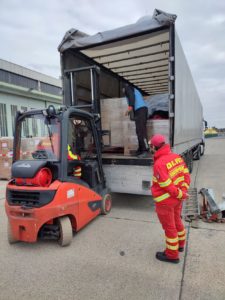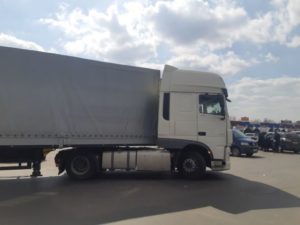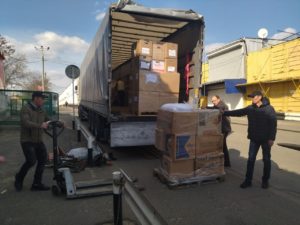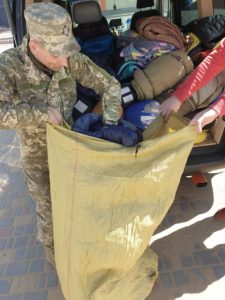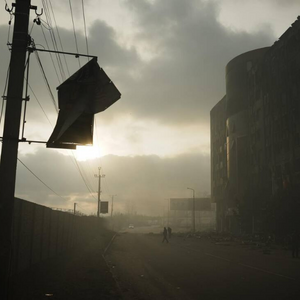The ongoing Russian attacks from the land, sea, and air have caused a humanitarian catastrophe with far-reaching consequences for people and supply chains, in Ukraine, and on a global scale. Within Ukraine, displaced people are increasingly in need of basics supplies, such as water, food, health, and shelter. In response the European Commission among many national and international non-profit organisations such as the Red Cross, UNHCR, Médecins Sans Frontières, have started to coordinate the delivery of humanitarian assistance for people in need. Here, figures of financial and material donations go into three-digit millions and are calculated in metric tonnes. On their websites, these organisations stress the size, efficiency and focus of their efforts at distributing humanitarian aid. Yet, when talking about local needs with government officials and volunteers in Moldova and in Southern Ukraine it turns out that often, needs don’t match supplies and the top-down organisation of aid can be slow, inflexible, and bureaucratic. In addition, speculation abounds about where the donation millions have disappeared. Given the deficiencies of large-scale aid missions, does it make sense to organise relief trucks through private initiatives? Will these comparatively small quantities be able to make any difference at all?
Based on my experience of organising humanitarian aid for a civic initiative in Chisinau, Moldova and for Odessa, Ukraine, in this post I want to reflect on the paradoxes and potential effects of this kind of activism. In contrast to the agencies mentioned above, we had no prior experience, nor large budgets to rely on. What turned out to be the major challenge, however, was not the financial aspect – people generously reacted to our call for donations. Rather, it were the navigation of cross-border regulations, shipping documents, and tax numbers. As the introductory sentence of a policy paper on humanitarian aid published by the European Commission notes: “all humanitarian operations depend on logistics, and logistics should be treated as a key priority in all humanitarian projects.”
Logistic operations in times of war
It took be a bit more than a month of humanitarian aid management to free myself from the globalization myth of seamless supply chain infrastructures. At the beginning of my engagement, and as an anthropologist of everyday geopolitics and trading infrastructures, I was curious to learn first-hand how the war affected trade routes and the mobility of goods and people. In my dissertation work, I am looking at socio-economic ties in times of geopolitical crises through the lens of market traders at the 7Km Market in Odessa and those of a peculiarly similar wholesale market in Bishkek, Kyrgyzstan. What stood out in the end, however, was less the extent to which supply chain operations have changed than how they remained the same, despite the war.
But let me first take you back to an incident some days ago in the advanced preparatory stage of organising a truck that was supposed to leave for Odessa the following day. I am sitting next to a Ukrainian driver called Alexey in the cabin of his 20 tonne truck. We have just finished the weighting of the load – roughly 10,000 kg of humanitarian aid. We hoped to go through the customs procedure afterwards, but it turned out that the timer of the driver’s hours regulation required a 45 minutes break. Bound to accept that we would not be able to reach the customs office in time, and stuck in an industrial no-man’s-land in the outskirts of Berlin, we discussed the unfolding of what has come to be a fully-fledged military attack on a sovereign country in the 21st Century. Alexey himself is from Mariupol and he immediately admits that he had always considered himself pro-Russian. On his 50th birthday, however, the day when the Russians attacked his hometown, his position has changed fundamentally. He began feeling like a Ukrainian from heart (становиться в душе Украинцем) as he puts it, an angry Ukrainian. Our talk is interrupted by a call from a befriended driver who is from Mariupol as well. Without ado a volley of curses ratters through the line. The driver next to me tries to stop his colleague, explaining that he is sitting in the cabin with a German woman who has organized a humanitarian aid truck for Odessa. But this remark just adds fuel to the fire and the voice in the phone shouts back “Fuck Odessa (Одеса на хуй) no one even gave a fuck about bringing water and food to Mariupol. As if they needed help in Odessa – it is Mariupol that has been fucked by everybody and that no one gives a shit about.” When they finish their call, the driver looks at me apologetically and sighs “we can start the engine in 30 seconds”.
This vignette captures well at least three paradoxes that crystalize in the mismatch of necessity and neo-liberal optimization processes. By this I refer to 1) the excessive complexity of logistics, 2) the sense of estrangement, evoked by the persistence of regulations such as the clocked schedules of the driver, and 3) the striking relevance of geography that takes shape in the form of blind spots of supply chain deliveries in previously well-connected places. In short, the unevenness of logistics, regulation, and geography and their interaction in times of war.
The paradoxes of war-time logistics, regulations, and geographies
The process from donation collection to purchasing and obtaining goods that are actually needed, payment, declaration, clearance and cross-border logistics presented substantial challenges for all parties involved in the work of delivering humanitarian aid to a war zone. Despite the fact that various governments announced an easing of cross-border regulations for relief deliveries to Ukraine, in practice many obstacles remained. Poland among others, decided to exempt humanitarian aid transport from road fees. To register as such, one has to send an email to the Polish government and provide information about the nature, time, and route of the truck. Unfortunately, the mixture of public and private motorway sections requires contacting not only the Ministry of infrastructure, but also a series of private companies, which makes it a complicated and piecemeal process. Sunday and public holiday driving bans have been lifted by some European countries, while others uphold these restrictions. Studying the list of the so-called “simplification measures” with the Ukrainian driver Alexey, he finally dismisses them all, arguing that he has a headache complying with tolls and driving hours already, better not to mess with that any further.
Alexey is confident that he can handle the road regulations. What is more challenging, though, are the shipping documents for the cross-border procedure. The most direct route to Odessa goes through Romania (Schengen border), and Moldova (European border). From the Moldova-Ukrainian border point in Palanca it takes 40 km to Odessa. When studying the different import, export, and transit regulations that are available only in national languages, I first use Google translate, then I call the German, the Romanian, and the Moldovan customs offices. The result of these calls is that no one actually knows the state of the art of customs clearance for humanitarian aid. The pieces of information I receive are vague if not contradictory. This cacophony of obscure simplification procedures gets even louder when talking to border officials.
Days pass and in trying to explain why all this takes so long to those waiting for the truck in Odessa, I just invoked disbelief. “We know that Europe is bureaucratic, but don’t they understand that we are in war?” I kept asking this myself. I also asked others sending aid trucks, and it turned out that many were struggling, because what looks easy from the outside contains devil in the details. Cross border regulations change from week to week, from border to border and from private entities to official organizations, for those having an EORI-Number (identification number for the importing and exporting of goods) or not, for medicines, for donations, or loads below or above 1,000 Euro. If, as in our case, you do not know in advance which route is the best, if you organize all this as a private person in the name of an organization who does not have an EORI number, and if your load is a mix of prescription medicines worth more than 50,000 Euros, need-based purchases and donations than the devil is all over.
Given the multiplication of potential problems with more than one border crossing, the driver in the end decides to cross the Polish-Ukrainian border and travel through a war-ridden country to Odessa, rather than crossing the safe space of European countries. Having arrived at the Polish border, the customs officers detect a switched digit in the number of pallets loaded. It is Friday night and they mercilessly demand that the driver solve the issue with the Berlin office on Monday. When the new shift arrives a couple of hours later, the drivers show them all shipment documents except the custom papers. They just wave him through. On the Ukrainian side of the border, more trouble was waiting for him. The officials there rejected the 7Km Market as receiving entity, despite the documents of the Odessean administration authorizing the market to do so. We decide not to pay the bribes and instead argued with them all night on the phone, until they finally let our humanitarian aid truck go.
Mission complete – was it worth it?
Still following the strict regulations of the driver’s watch, Alexey finally arrives in Odessa two days later. A welcome committee receives him warmly. In a video call we recapitulate again on the complex regulatory machinery and the human labour required to move humanitarian aid along and across European and non-European borders. We all agree that despite the trouble and the different perspectives from which we had to deal with fractious logistic procedures, it brought us closer together and considerably increased the value of the effort as such.
Finally, my answer to the question whether it makes sense to organise such initiatives on a grassroot level is a clear yes. They can have a strong symbolic and psychological effect that helps building relations and connect people in mutually beneficial ways. The direct, non-mediated nature of these deliveries creates trust, which is not always the case with large-scale organisations. This positive effect that was pushed even further due to detailed description and visualization of the delivered products (things that were actually needed) and their places of distribution (such as to a children’s hospital). Many of my previous informants at the market shared the media publications on the delivery in their social media networks.
There is more to our deliveries than a symbolic value, though. In this post I depicted the persistence of highly complex and obscure cross-border regulations. At the same time it has become very difficult to reach different regions in Ukraine. Mariupol is one of the most devastating examples. But the case of Odessa is striking as well, because the city is famous for its port and the wholesale market 7Km, and it has always been a trading centre with global transportation connections. Indeed, our humanitarian aid truck was able to bring some relief to a place that was used to plenitude, but which the war is transforming into a barely connected periphery.
About the author: Claudia Eggart writes her PhD in social anthropology at the University of Manchester and works as a researcher at the Centre for East European and International Studies in Berlin. In her dissertation she explores how traders at wholesale markets in Ukraine and Kyrgyzstan negotiate geopolitics and economics in everyday practices and vernacular imaginary.
This blog is part of the forum: Making sense of the war in Ukraine
